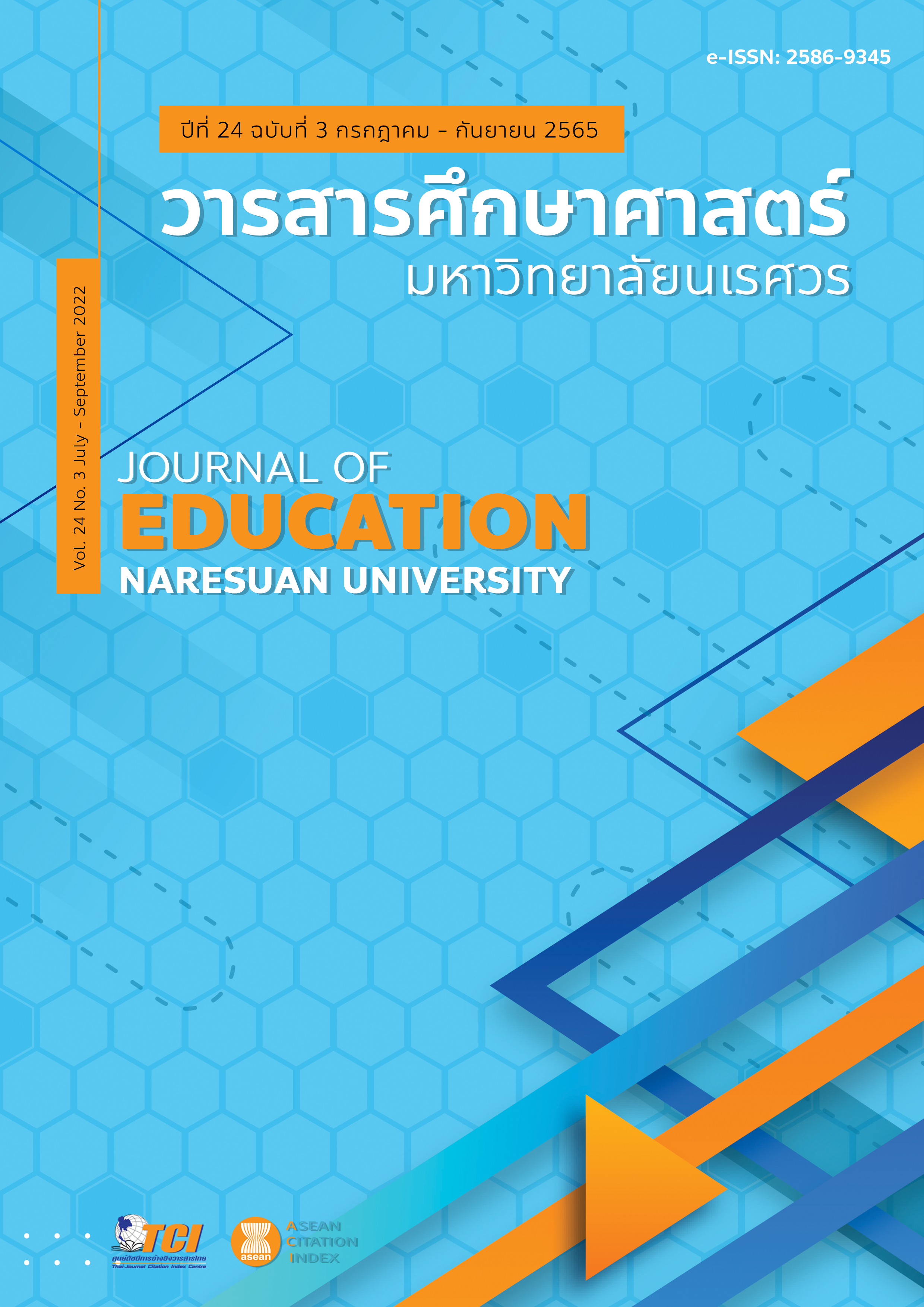PHYSICAL FITNESS AND ABDOMINAL OBESITY IN UNIVERSITY STUDENTS สมรรถภาพทางกายและภาวะอ้วนลงพุงของนิสิตมหาวิทยาลัย
Main Article Content
Abstract
The purposes of this investigation were to study the physical fitness and abdominal obesity in university students. The research was a study of cross-sectional design. Participants were 3,672 Naresuan University students who enrolled Sports and Exercise course. They were selected by purposive sampling and were students of 3 groups of faculties: 1) Health Sciences, 2) Sciences and Technology, and 3) Humanities and Social Sciences. The variables of physical fitness and central obesity were collected before course starting in 2nd - 3rd week and after course ending in 15th - 16th week of semester. The research instrument was health-related physical fitness testing. The outcomes were analyzed using mean, SEM, percentage, and ANOVA with repeated measures followed by LSD’s multiple comparison. The results were showed that after course ending, grip strength, abdominal strength and endurance, and cardiorespiratory endurance of Sciences and Technology students were better than Health Sciences and Humanities and Social Sciences groups. At the end of the course there were significant improvement in all groups at .05 level in flexibility, upper body, abdominal, and lower body muscular fitness, and cardiorespiratory endurance. Abdominal obesity was apparently found in female in all groups of faculties. The waist circumference was greater in male and female of Humanities and Social Sciences students. The findings of this study were showed that physical activity in Sports and Exercise course can partly improve physical fitness in university students. Students should be suggested about exercise on how to do in the right way and be set exercise program consistent with principles of exercise. These findings can be useful to further planning on setting of environment in all faculties in the university for health promotion in university students.
Article Details

This work is licensed under a Creative Commons Attribution-NonCommercial-NoDerivatives 4.0 International License.
The owner of the article does not copy or violate any of its copyright. If any copyright infringement occurs or prosecution, in any case, the Editorial Board is not involved in all the rights to the owner of the article to be performed.
References
American College of Sports Medicine (ACSM). (2018). ACSM’s guidelines for exercise testing and prescription. Philadelphia: Lippincott Williams and Wilkins.
Buaduang, N., Sangtong, N., & Khongchawan, K. (2013). Health-related physical fitness of year 1 students in Thaksin university Songkhla campus. Social Sciences Research and Academic Journal, 8(23), 75-90. [in Thai]
Chaimay, B., & Woradet, S. (2015). Factors related to metabolic syndrome among students in Thaksin university, Phatthalung campus. The Public Health Journal of Burapha University, 10(2), 204-206. [in Thai]
Department of Health: Ministry of Public Health. (2013). Prevention and treatment of non-communicable diseases with exercise (2nd ed.). Bangkok: The Agricultural Cooperative Federation of Thailand. [in Thai]
Ghouse, S. M., Barwel, S. B., & Wattamwar, A. S. (2016). A review on obesity. Health Science Journal, 10(4), 1-5.
Haff, G. G., & Dumke, C. (2012). Laboratory manual for exercise physiology. United States of America: Human Kinetics.
Jaruchart, T. (2020). Autonomic nervous system activity and heart rate variability in obesity. Journal of Sports Science and Health, 21(2), 177-194. [in Thai]
Khamchata, L., Dumrongpakapakorn, P., & Theeranut, A. (2018). Metabolic syndrome: Dangerous signs required managment. Srinagarind Medical Journal, 33(4), 386-395. [in Thai]
Kritpet, T. (2011). Exercise physiology. Bangkok: Tiranasar. [in Thai]
Kung, Y. T., Chang, C. M., Hwang, F. M., & Chi, S. C. (2020). The association between body mass index and physical fitness of normal weight/overweight/obese university students. International Journal of Environmental Research and Public Health, 17(15), 5391. doi: 10.3390/ijerph17155391
No-in, K. (2017). Overweight and obesity among Thai school-aged children and adolescents. Journal of the Royal Thai Army Nurses, 18, 1-8. [in Thai]
Onlamai, K. (2007). Risk factors associated with metabolic syndrome in type 2 diabetic patients at Bhumibol Adulyadej hospital (Master thesis). Bangkok: Chulalongkorn University. [in Thai]
Pookpun, S., Rungsayatorn, S., & Saratapun, N. (2017). Knowledge, attitude, and at-risk behaviors for non-communicable diseases of public university students in Bangkok. Kasetsart Journal of Social Sciences, 38, 668-678. [in Thai]
Ravinit, P., & Sattam, A. (2016). Factor associated with the metabolic syndrome in Chamab sub-district, Wang Noi district, Ayutthaya Province. APHEIT Journal Science & Technology, 5(2), 33-47. [in Thai]
Sport Science Bureau. (2019). Manual of physical fitness testing and norm of children, youth, and Thai population. Bangkok: World Expert. [in Thai]
Suksom, D. (2018). Exercise for health. Bangkok: Chulalongkorn University Press. [in Thai]
Supwarobol, S., Chantarasinlapin, P., & Techasukthavorn, V. (2020). Nutrition and weight management. Bangkok: Chulalongkorn University Press. [in Thai]
Thai Health Promotion Foundation. (2018). Health-related physical fitness testing for people. Retrieved January 22, 2021, from http://www.cusc.chula.ac.th/wordpress/wp-content/uploads/2018/08/12fc494839335ca0e77b12f248602a74.pdf
Thongtaeng, P., & Seesawang, J. (2012). Overweight in Thai children. Ramathibodi Nursing Journal, 18 (3), 287-297. [in Thai]
Tinkajee, S., & Pumwiset, P. (2016). Behavioral strategies for losing weight among undergraduate students in Nonthburi province. Journal of Graduate Studies Valaya Alongkorn Rajabhat Univesity, 10(1), 72-82. [in Thai]
World Health Organization (WHO). (2021). Obesity. Retrieved January 22, 2021, from https://www.who.int/news-room/fact-sheets/detail/obesity-and-overweight
Youngyuen, K. (2016). Metabolic syndrome. Government Pharmaceutical Organization, 23(2), 17-20. [in Thai]


